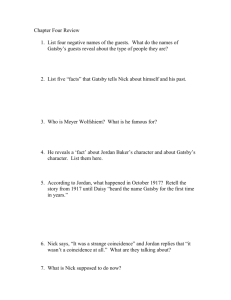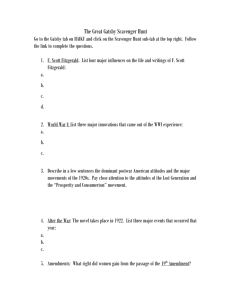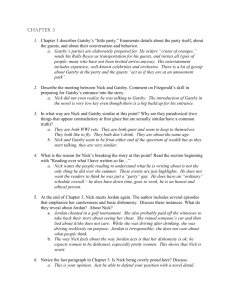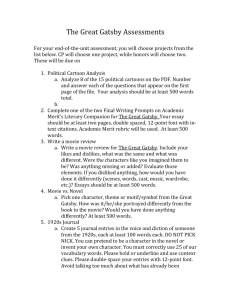Jaunty Salute - English at UGA
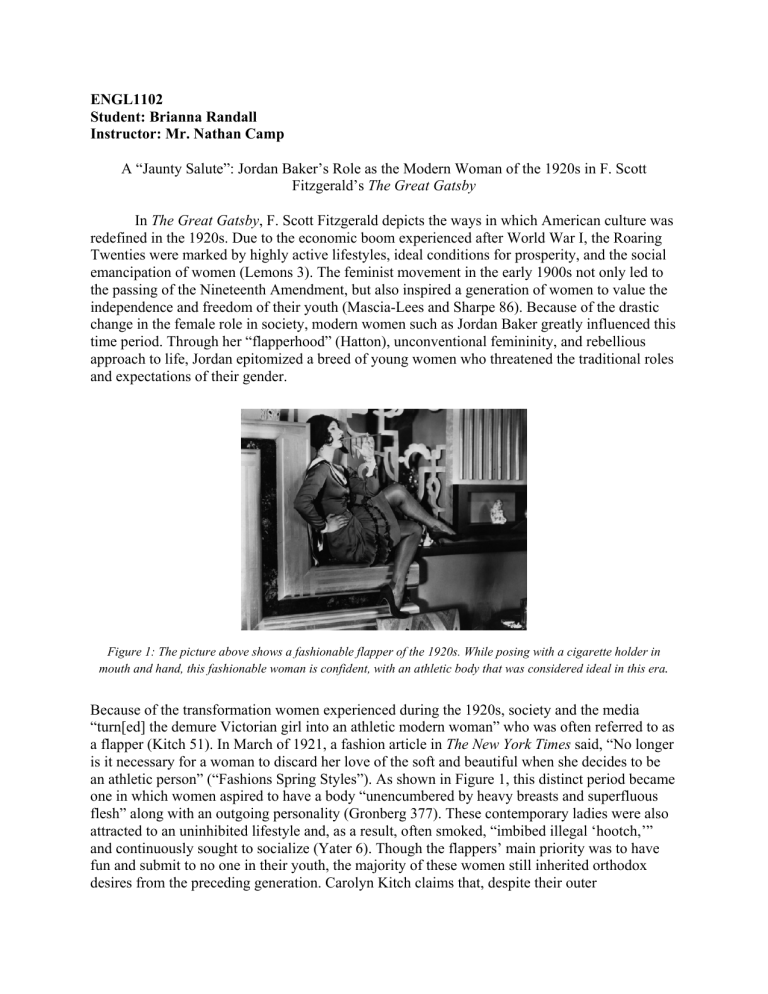
ENGL1102
Student: Brianna Randall
Instructor: Mr. Nathan Camp
A “Jaunty Salute”: Jordan Baker’s Role as the Modern Woman of the 1920s in F. Scott
Fitzgerald’s
The Great Gatsby
In
The Great Gatsby
, F. Scott Fitzgerald depicts the ways in which American culture was redefined in the 1920s. Due to the economic boom experienced after World War I, the Roaring
Twenties were marked by highly active lifestyles, ideal conditions for prosperity, and the social emancipation of women (Lemons 3). The feminist movement in the early 1900s not only led to the passing of the Nineteenth Amendment, but also inspired a generation of women to value the independence and freedom of their youth (Mascia-Lees and Sharpe 86). Because of the drastic change in the female role in society, modern women such as Jordan Baker greatly influenced this time period. Through her “flapperhood” (Hatton), unconventional femininity, and rebellious approach to life, Jordan epitomized a breed of young women who threatened the traditional roles and expectations of their gender.
Figure 1: The picture above shows a fashionable flapper of the 1920s. While posing with a cigarette holder in mouth and hand, this fashionable woman is confident, with an athletic body that was considered ideal in this era .
Because of the transformation women experienced during the 1920s, society and the media
“turn[ed] the demure Victorian girl into an athletic modern woman” who was often referred to as a flapper (Kitch 51). In March of 1921, a fashion article in
The New York Times
said, “No longer is it necessary for a woman to discard her love of the soft and beautiful when she decides to be an athletic person” (“Fashions Spring Styles”). As shown in Figure 1, this distinct period became one in which women aspired to have a body “unencumbered by heavy breasts and superfluous flesh” along with an outgoing personality (Gronberg 377). These contemporary ladies were also attracted to an uninhibited lifestyle and, as a result, often smoked, “imbibed illegal ‘hootch,’” and continuously sought to socialize (Yater 6). Though the flappers’ main priority was to have fun and submit to no one in their youth, the majority of these women still inherited orthodox desires from the preceding generation. Carolyn Kitch claims that, despite their outer
transformation and bold behavior, these moderns ultimately hoped for a conventional lifestyle that would resemble their mothers’ and involve marriage, the support of a man, and children
(12).
Due to the prominence of the flapper image during the Jazz Age, Fitzgerald created the character of Jordan Baker to fit this stereotype. When Nick first encounters her, she is “extended full length at her end of the [Buchanans’] divan” ( Gatsby 13). This relaxed position suggests that she has a care-free attitude, which was common for females in this era. The narrator also claims that Jordan’s “complete self sufficiency draws a stunned tribute from [him]” (13). In this statement, he is not only addressing the pride and self-esteem the character exudes while keeping her chin raised and refusing to acknowledge his presence, but also describing a haughtiness that was unremarkable for a young lady of the Roaring Twenties to possess.
Even Jordan Baker’s flapper physique reminds readers of the ideal woman of the era when Nick describes her as a “slender, small breasted girl” (
Gatsby
15). In addition, he notices a vivacity in her movements and how she self-assuredly wears her evening dresses like sportswear.
The young man then confirms this tomboyish body type as the most accepted of the time when he lustfully admits, “I enjoyed looking at her” (15). The narrator also mentions the “erect carriage” she made by thrusting “her body backward at the shoulders like a young cadet” (15).
Again, this bold mannerism reinforces the reader’s impression of her as slightly vain, with the stern posture of an athlete.
Various details and moments unveil Jordan Baker’s liberated lifestyle, as well. Because
Jordan is the first character to mention Gatsby’s name to the narrator, readers can loosely assume that she is highly social. This assumption is then supported when Nick sees her at one of
Gatsby’s lavish parties, which notoriously attract people who enjoy socializing. Readers can also conclude that Jordan is familiar with convivial gatherings when she “[holds Nick’s] hand . . . as a promise that [she will] take care of [him]” (
Gatsby
47). This idea of a woman taking a man’s hand and making him feel secure is also a gender reversal that emphasizes the extroverted nature of women in the 1920s and the consequent shift in gender roles. Later, Jordan approves of big and extravagant parties, which she believes are more intimate. This statement corroborates the idea that she is more comfortable amidst confusion and excitement than in smaller, quieter places that, contrary to her opinion, do provide more privacy. Further in the story, Nick then addresses the character’s provocative social life when he explains how the “uncertainty of her own movements between hotels and clubs and private houses [make] her hard to find” (
Gatsby
162).
The Victorian desire that even these independent women had to find stability is also seen in Baker. Shortly after she and Nick stop seeing each other romantically, the two speak of their past. Without hesitation, Jordan tells the narrator that she is engaged to another man. She then denies having any emotional feelings for Nick and coldly shakes his hand. Unable to end the conversation without venting her frustration, the female golfer admits to foolishly thinking that
Nick was a respectable man and accuses him of “throw[ing] [her] over” (
Gatsby
186). This conversation strongly suggests that Jordan valued her companionship with Nick and was disappointed when it ended. Considering Nick’s opinion of her as “incurably dishonest,” the young woman is probably lying about being engaged, but even her deceit implies how badly she longs for serious romance and hopes to end an adventurous youth with traditional domesticity
(63).
During the Jazz Age, young moderns were, aside from their “positively tomboyish” physical features and gregariousness, characterized by their redefined femininity, which combined natural beauty with elements that were, by tradition, considered rather masculine
(Kitch 51). Because of the new-found strength they gained from the women’s rights movement of the twentieth century, females of this period “boast[ed] of their muscle and how they [could] play golf all day then dance . . . half the night, without turning a hair” (Kitch 53). Health and exercise were also popular editorial themes geared towards women in magazines and newspapers
(53). In these articles, females were encouraged, after a day of work, to engage in swimming, basketball, and boxing (53). Even girls on the covers of magazines were often shown outside of the home environment, causing women to expand their collective place in society and become more comfortable steering away from the behavioral norms to which their mothers conformed
(Kitch 54; 53).
As a complete representation of the new woman of the 1920s, Jordan Baker reflects this shifting conception of the feminine woman in two distinct ways: physically and professionally.
She has an athletic build with “slender muscles in her arms” so, when Nick calls her a “good illustration,” he means that she strongly resembles the sporty women portrayed in the media
(
Gatsby
22; 185). While dressed in golf clothes with a fingerless glove and her chin slightly raised, the female player could easily have been a “Girl of Today” featured in the magazine
Good Housekeeping
in the 1920s (Kitch 53). Fitzgerald even reveals an actual source that inspires the character to epitomize the “Outdoor Pal” image when Nick sees her reading
The
Saturday Evening Post , a newspaper that often placed women with contemporary attractiveness on its cover: tomboys (53).
Though sports were still considered “inappropriate for white women because of [their] masculinizing influence,” Jordan’s professional golf career implies that women who played sports during the Roaring Twenties possessed a new-fashioned charm (Wachs 356). Like the true modern of the decade, she remains physically fit,and her interests lie in activities viewed as manly by America’s preceding generation. Readers can first assume that Jordan is accustomed to physical activity when she becomes stiff after sitting down on the Buchanans’ sofa for a long period of time. The fact that training for the season makes her reluctant to take a leisurely trip to
New York also proves how dedicated the woman is to remaining in optimal condition for her career. Baker even refuses to consume alcohol while training, which is evident when she does not drink the four cocktails in front of her at the Buchanans’ house. Not only does this refusal prove her commitment to sports, but it also highlights the character’s willingness to alter her unhealthy lifestyle for the well-being of her athletic performance. Overall, Jordan is serious about a career that was, for women, seen as untraditional yet captivating, allowing her to further exude the confidence women felt in their physical capabilities.
Another “remarkably identifiable” trait that characterized the ideal woman of the Jazz
Age was her revolutionary manners and morals (Hatton). Generally, young women “disavow[ed] the old-time proprieties” and, according to the Duke Chronicle in 1927, were “wild and reckless and radical” when compared to the modest females of the Victorian Era (qtd. in Fass 225). A prime example was the seventeen year old “flapper bandit” who robbed several Chicagoans in
1921 (“Flapper Bandit”). Though several men assisted her, she “carried the only visible weapon and did all the dangerous work” (“Flapper Bandit”). Much like Susan B. Anthony and other influential feminists of this time period, these daring souls had a “lawless way of thinking and acting, which men [thought] wonderfully fascinating in a belle” (Harper 398).
Though the women of this era were largely known for their venturesome ways, the rebellion that Jordan portrays is relatively extreme. According to Daisy, “her family is one aunt about a thousand years old,” meaning that Jordan was raised by a woman potentially old enough to be her grandmother (
Gatsby
23). Because her aunt is a product of a period that expected politeness and humbleness from the ideal woman, her strict teachings could have heightened
Jordan’s desire to rebel against the once popular Victorian image and contrast it entirely with a
“devil-may-care attitude” (Hatton).
Through Nick’s detailed narration, Jordan’s corrupt tendencies become increasingly evident. Readers are first made aware of the “incurably dishonest” side of this character when the narrator tells them that she lied about leaving a borrowed convertible car in the rain with the top down ( Gatsby 63). Her blatant disregard for morality is also implied by the scandal that she cheated to win her first major golf tournament. According to the narrator, she was accused of moving her ball from a “bad lie in the semi-final round” (62). The woman “instinctively avoid[s] clever shrewd men . . . because she [feels] safer on a plane where any divergence from a code would be thought impossible” (63). This means that Jordan stays around other truthful people with higher ethical values so that her manipulative acts are less likely to be discovered. In Nick’s opinion, she has been “dealing in subterfuges” for a long time: hence, her mastery of keeping a
“cool insolent smile” while tending to her selfish wishes (63).
A specific example of Jordan’s ruthlessness is her idea of safe driving. After she almost hits a man, Nick calls her a “‘rotten driver’” and tells her to be more cautious ( Gatsby 63).
Jordan then argues that her irresponsible driving is acceptable because others are careful while on the road. “Suppose you met somebody just as careless as yourself,” the narrator wonders aloud (63). Though crossed out by Fitzgerald himself in the novel’s manuscript, Jordan originally responds by saying, “I always avoid that carefully,” meaning that she not only avoids careless drivers, but inconsiderate and thoughtless people as well (“Facsimile” 123). Before trusting the reader to understand this point, Fitzgerald writes this line as validation of the narrator’s aforementioned observation about her. Here she admits to surrounding herself with those mindful of the consequences of their actions, allowing her to fulfill her self-centered desires at their expense. Though in this moment she is insensitive, Nick still admits to loving her.
“It [makes] no difference to me,” says the young man, despite his awareness of her heedless ways (
Gatsby
63).
In “The Flapper,” Dorothy Parker perfectly described the free, audacious spirit that women shared during her time.
She’s not what Grandma used to be, −
You might say, au contraire.
Her girlish ways may make a stir,
Her manners cause a scene. (Parker)
In
The Great Gatsby
, Jordan Baker represents not only the words of this poem, but also the strong presence of the modern woman in the 1920s. In an effort to break down the societal wall between the genders, females like Baker turned their backs on restricted lives for the freedom to live up to every dare. Though their breasts were taped and their curves concealed, their “female gaze” warned men (Kitch 54). I will “get [you] young,” it sweetly said, “and treat [you] rough”
(Parker).
Works Cited
A Model Flapper: A Fashionable Woman Posing with a Cigarette Holder . 01 Jan. 1925. Getty
Images. <A href=“http://search.ebscohost.com/login.aspx?
direct=true&db=imh&AN=imh222024&site=ehost-live”>A Model Flapper A fashionable woman posing with a cigarette holder. (Photo by General Photographic Agency/Getty
Images) – Image Date: 01/01/1925 – Image Date: 01/01/1925</A>.
“Fashions Spring Styles.”
The New York Times
6 Mar. 1921: 77.
ProQuest Historical
Newspapers . ProQuest. U of Georgia Main Lib.13 Nov. 2008
<http://www.proquest.com/>.
Fass, Paula S.
The Damned and the Beautiful: American Youth in the 1920s
. New York: Oxford
UP, 1977.
Fitzgerald, F. Scott. “The Great Gatsby: A Facsimile of the Manuscript.” Ms. Edited by Matthew
J. Bruccoli, 1973. U of South Carolina, Washington, D.C.
—.
The Great Gatsby
. New York: Simon & Schuster Inc., 1995.
Gronberg, Tag. “Beware Beautiful Women: The 1920s Shopwindow Mannequin and a
Physiognomy of Effacement.”
Art History
20.3 (1997): 375. Academic Search
Complete. EBSCOhost. U of Georgia Main Lib. 13 Nov. 2008
<http://search.ebscohost.com/login.aspx?direct=true&db=a9h&AN=9710111450&site=e host-live”>.
Harper, Ida Husted.
The Life and Work of Susan B. Anthony: Volume 1
. Charleston:
BiblioBazaar, LLC, 2007. 9 Nov. 2008 <http://books.google.com/books?
id=qBReXW0VaEUC&printsec=frontcover&dq=life+and+work+of+susan+b.
+anthony+by+harper>.
Hatton, Jackie. “Flappers.”
St. James Encyclopedia of Popular Culture
. AccessMyLibrary. 2008.
Thompson Corporation. 9 Nov. 2008
<http://www.accessmylibrary.com/coms2/summary_0193-10195_ITM>.
“Held as ‘Flapper Bandit’: But Girl of 17 Denies She Has Been Robbing Chicagoans.”
The New
York Times 21 Apr. 1921: 5. ProQuest Historical Newspapers . ProQuest. U of Georgia
Main Lib. 13 Nov. 2008 <http://www.proquest.com/>.
Kitch, Carolyn A.
The Girl on the Magazine Cover: The Origins of Visual Stereotypes in
American Mass Media . Chapel Hill: U of North Carolina Press, 2001.
Lemons, Stanley J.
The Woman Citizen: Social Feminism in the 1920s
. Charlottesville: UP of
Virginia, 1990.
Mascia-Lees, Frances E. and Patricia Sharpe, eds.
Tattoo, Torture, Mutilation, and Adornment:
The Denaturalization of the Body in Culture and Text . Albany: SUNY P, 1992. 17
Nov. 2008 <http://books.google.com/books?
id=DWMLlOW3KO8C&pg=PP5&source=gbs_selected_pages&cad=0_1#PPP9,M1>.
Parker, Dorothy. “The Flapper.” Electric Apocalypse . 18 Nov. 2008 <http://www.stonebench.us/
flapper.html>.
Wachs, Faye Linda. “Gender and Society.” Rev. of
Coming on Strong: Gender and Sexuality in
Twentieth Century Women’s Sport , by Susan K. Cahn and Women in Baseball: Forgotten
History
, by Gai Ingham Berlage. Sage Publications, Inc. Jun. 1996: 353-55. 9 Nov. 2008
<http://www.jstor.org/stable/189704?seq=1>.
Yater, George H. Flappers, Prohibition, and All That Jazz . Louisville, KY: Museum of History and Science, 1984.
Works Consulted
Carter, Paul A.
The Twenties in America
. Arlington Heights: Harlan Davidson, c1975.
Inge, Thomas M., ed.
Handbook of American Popular Culture
. Westport, CT: Greenwood P,
1978-1981.
Parker, Dorothy.
Not So Deep as a Well
. New York: Viking Press, 1936.
